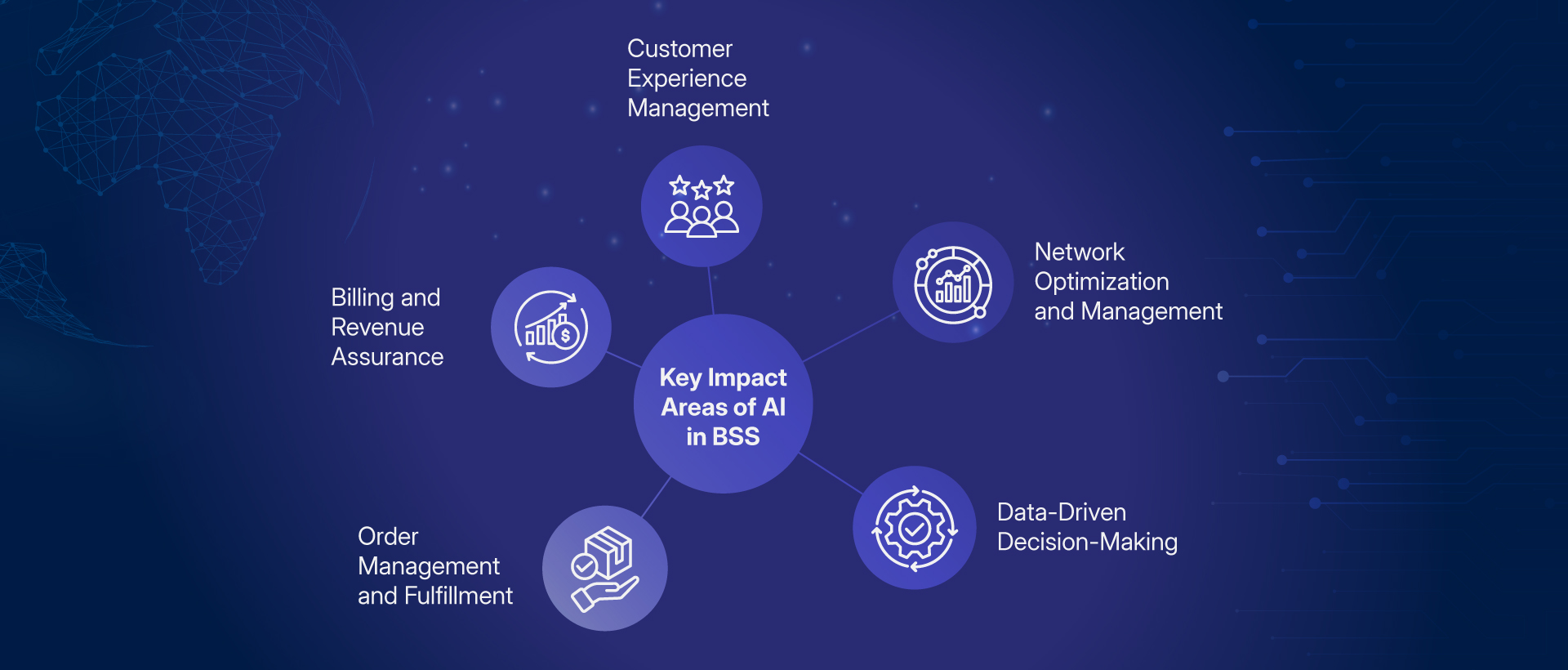
The Future of BSS: Unlocking the Potential of AI in Telecom
Introduction
In the rapidly evolving telecommunications sector, Business Support Systems (BSS) are poised for significant transformation through the integration of Artificial Intelligence (AI). AI technologies, such as machine learning (ML)—which enables systems to learn from data and improve performance—and generative AI—which creates new content, solutions, and predictions—are reshaping BSS. Historically, BSS has served as the backbone of telecom operations, managing essential functions like customer interactions, billing, and order fulfillment. However, AI integration represents a major leap forward, offering the potential to automate complex operations, anticipate client needs, and enhance service delivery. By deeply integrating AI into BSS frameworks, telecom businesses can achieve real-time data analytics, automate routine processes, and efficiently scale operations. Telecom companies utilize AI alongside BSS software for various applications, including customer retention, chatbots, revenue and cost predictions, customer analysis, customer experience management, automation, process reengineering, simulations, quality improvements, and fraud and anomaly detection.
Key Drivers Enabling AI Integration in BSS
- Business agility is a crucial feature of BSS as companies adapt and new possibilities arise. AI plays a vital role in identifying these opportunities and creating new business models to capitalize on them. Several telecom operators use AI to quickly design and deploy new services customized to changing client needs, allowing them to remain competitive in a dynamic market.
- Industry Maturity is leading to progressively lower business transaction costs, evidenced by successful platform players such as telecom giants. These companies integrate AI into their BSS to streamline operations, reduce costs, and improve customer service.
- Cloud Infrastructure significantly enhances the incorporation of AI into BSS capabilities. With its deployment flexibility, elastic scalability, and microservices architecture, the cloud seamlessly integrates AI into BSS systems. These features enable more efficient resource management, quicker deployment of AI-driven solutions, and a flexible system architecture, allowing telecom businesses to innovate and respond swiftly to market demands. The cloud’s inherent ability to handle large volumes of data and complex computational tasks further drives AI adoption within BSS, leading to greater operational efficiency and an improved user experience.
Key Challenges to adding AI to BSS
- AI Adoption: Successfully integrating AI in Business Support Systems (BSS) requires a two-pronged strategy. First, advanced trainings of the organization's personnel are required to guarantee that employees are proficient in the use of new AI tools and processes. Those trainings are critical for reaping the full benefits of AI-powered insights and automation. Second, the present business rules, procedures, and systems need to be reengineered. This reengineering often entails assessing and rebuilding existing systems in order to easily integrate AI, which may include revamping workflows, updating software, and ensuring that all business processes are in sync with the new AI capabilities. Without taking these steps, businesses may struggle to fully capitalize on the potential revenue improvements that AI may provide.
- Siloed Systems: Traditional, non-AI-native BSS are divided into silos, reducing AI efficiency and necessitating costly integration efforts and system reconfigurations, which can lead to performance concerns. Operators needs to do extensive integration work to integrate its BSS and ensure that AI could be implemented efficiently across several platforms. This can be solved by designing modular, microservices-based designs that make it easier to integrate AI components.
- Complex KPIs: Complex business situations require breaking down main KPIs into sub-intents based on various data sets and algorithms, which are then integrated by a super-algorithm. This can risk losing business control and limits opportunities for reuse or experience building. A real-world case involved a telecom company struggling with KPI management due to the complexity of AI models. One solution is to implement AI governance frameworks that ensure transparency and control over how KPIs are managed and integrated.

Key Impact Areas of AI in BSS
- Customer Experience Management: AI transforms customer experience management by enabling more personalized, responsive, and effective interactions. Machine learning models, trained on vast datasets of client interactions, forecast preferences, tailor products, and anticipate service issues before they occur. Natural Language Processing (NLP)-powered chatbots and virtual assistants, designed with sophisticated language models, provide 24-hour assistance by addressing frequent client concerns without human participation. These systems leverage historical consumer behavior and sentiment to deliver appropriate responses, enhancing customer satisfaction while significantly reducing operational costs.
- Billing and Revenue Assurance: AI enhanced BSS boosts billing accuracy, crucial for client retention and consistent income.These systems employ machine learning algorithms trained on past billing and consumption data to detect anomalies, such as potential fraud, income leakage, and billing cycle problems, before they affect customers. AI also recommends dynamic pricing models by analyzing real-time data, ensuring pricing strategies align with client usage patterns and market demand, allowing businesses to maximize their revenue streams.
- Order Management and Fulfillment: In telecoms, AI-powered BSS automates order processing, anticipates delays, and optimizes resource allocation. Machine learning algorithms, trained on data from network performance and customer orders, can predict problems such as network congestion or equipment failure. This predictive capability enables businesses to redirect orders or deploy additional resources proactively, resulting in faster order fulfillment, fewer errors, and improved customer experiences.
- Network Optimization and Management: With the arrival of 5G, IoT, and edge computing, telecommunications networks have become more complex. AI integration in BSS is critical for optimizing these networks. Predictive analytics and machine learning models track network traffic, identify bottlenecks, and anticipate maintenance requirements. These models, trained on substantial network performance data, support a proactive approach to network management, reducing downtime and ensuring peak network performance, which directly enhances customer service quality.
- Data-Driven Decision-Making: AI enables telecom companies to make more accurate and timely data-driven decisions. BSS includes advanced analytics tools that examine huge amounts of data from user interactions, network performance, and market trends. This real-time research provides actionable information to assist with strategic decisions such as launching new products and services and optimizing existing offers. AI-powered decision-making tools also assist with scenario planning, allowing firms to simulate different business strategies and predict their outcomes.
Conclusion
The integration of AI in Business Support Systems is revolutionizing the telecommunications industry, enabling companies to deliver more personalized, efficient, and reliable services. However, the journey towards AI-powered BSS is not without its challenges, and companies must navigate these carefully to fully realize the benefits. As AI continues to advance, its role in BSS will undoubtedly grow, driving the next wave of innovation in telecommunications and other industries.
Looking for an agile transformation journey?